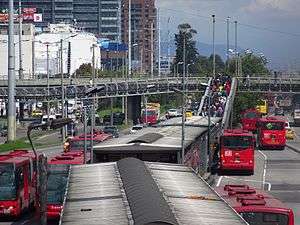Calle 106 (TransMilenio)
The simple station Calle 106 is part of the TransMilenio mass-transit system of Bogotá, Colombia, which opened in the year 2000.
| Calle 106 | ||||
|
| ||||
| Location | Autopista Norte with Calle 105 | |||
| Neighborhood | Usaquén and Suba | |||
| Opened | 2001 | |||
Location
The station is located in northern Bogotá, specifically on Autopista Norte with Calle 105.
It serves the Santa Bibiana, Estoril and San Patricio neighborhoods.
History
After the opening of the Portal de Usme in early 2001, the Autopista Norte line was opened. This station was added as a northerly expansion of that line, which was completed with the opening of the Portal del Norte later that year.
The station is named Calle 106 due to its proximity to that important road in northeastern Bogotá.
Nearyby are locations of Jasban (dental clinic) and the main clinic of the EPS Colsanitas.
On the night of April 9, 2013, attacks against this system station were recorded. On that occasion, the stations Calle 100 (TransMilenio), Calle 106 (TransMilenio), Prado, Alcalá, Calle 142 (TransMilenio), Calle 146 (TransMilenio), Mazurén (TransMilenio), Calle 161 (TransMilenio), Calle 187 (TransMilenio), and Terminal (TM) with Autopista Norte, where they left $ 22 million Weights in losses
Station Services
Old trunk services
| Kind | Routes | Frequency |
|---|---|---|
| Current | Every 3 minutes on average | |
| Express | Every 2 minutes on average |
Main line service
| Type | Northwards | Southwards | Frequency | ||||||
|---|---|---|---|---|---|---|---|---|---|
| Local |
|
|
Every three minutes | ||||||
| Express Monday through Saturday All day |
|
|
Every two minutes | ||||||
| Express Monday through Saturday Mixed service, rush and non-rush |
|
|
Every two minutes |
Feeder routes
This station does not have connections to feeder routes.
Inter-city service
This station does not have inter-city service.
External links
See also
- Bogotá
- TransMilenio
- List of TransMilenio Stations
